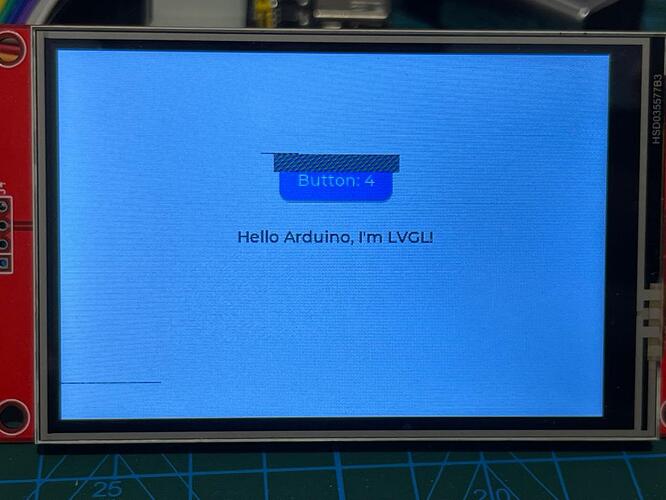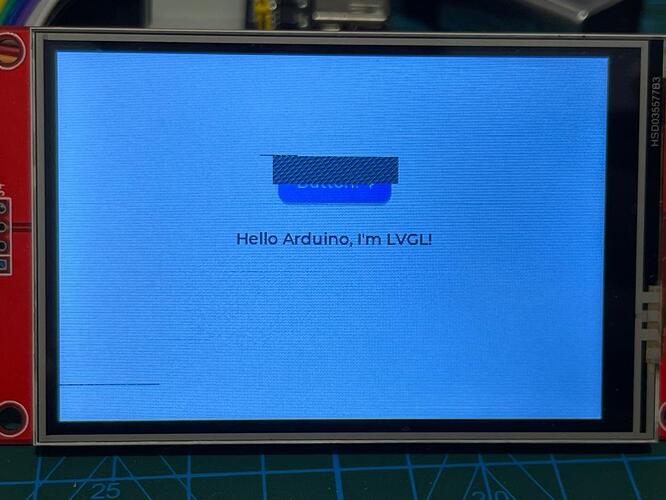Description
I’m quite a newbie in ESP32, and recently I found that LVGL is quite interesting and would like to try to make it work on the TFT I have bought. I have tried to use the online tutorial example to run LVGL on TFT for testing. However, I found the screen is showing some glitch, like keep scanning line & it looks like noise. I had tried so many solution, however, seems like they are not resolving it.
I had tried also using XPT2046 library, however, same glitches shown.
The issue start show when I call “tft.getTouch(…)”
Do anyone have experience on this?
Any help is appreciated
What MCU/Processor/Board and compiler are you using?
ESP32-S3 Dev. Module; VSCode with PlatformIO; Framework: Arduino
TFT ILI9488 3.5", with Touch XPT2046
What LVGL version are you using?
Latest (Master), v9.2
What do you want to achieve?
Getting TFT & Touch done without glitches
What have you tried so far?
As included on the description above
Code to reproduce
Add a code snippet which can run in the simulator. It should contain only the relevant code that compiles without errors when separated from your main code base.
The code block(s) should be formatted like:
#include <Arduino.h>
#include <lvgl.h>
#if LV_USE_TFT_ESPI
#include <TFT_eSPI.h>
#endif
/*Set to your screen resolution and rotation*/
#define TFT_HOR_RES 480
#define TFT_VER_RES 320
#define TFT_ROTATION LV_DISPLAY_ROTATION_270
/*LVGL draw into this buffer, 1/10 screen size usually works well. The size is in bytes*/
#define DRAW_BUF_SIZE (TFT_HOR_RES * TFT_VER_RES / 10 * (LV_COLOR_DEPTH / 8))
uint32_t draw_buf[DRAW_BUF_SIZE / 4];
#if LV_USE_LOG != 0
void my_print(lv_log_level_t level, const char *buf)
{
LV_UNUSED(level);
Serial.println(buf);
Serial.flush();
}
#endif
TFT_eSPI tft;
/*Read the touchpad*/
void my_touchpad_read(lv_indev_t *indev, lv_indev_data_t *data)
{
// For example ("my_..." functions needs to be implemented by you)
uint16_t x, y;
bool touched = tft.getTouch(&x, &y);
if (!touched)
{
data->state = LV_INDEV_STATE_RELEASED;
}
else
{
data->state = LV_INDEV_STATE_PRESSED;
data->point.x = x;
data->point.y = y;
}
}
/*use Arduinos millis() as tick source*/
static uint32_t my_tick(void)
{
return millis();
}
static void btn_event_cb(lv_event_t *e)
{
lv_event_code_t code = lv_event_get_code(e);
lv_obj_t *btn = (lv_obj_t *)lv_event_get_target(e);
if (code == LV_EVENT_CLICKED)
{
static uint8_t cnt = 0;
cnt++;
/*Get the first child of the button which is the label and change its text*/
lv_obj_t *label = lv_obj_get_child(btn, 0);
lv_label_set_text_fmt(label, "Button: %d", cnt);
}
}
void lv_example_btn_1(void)
{
lv_obj_t *btn_label;
lv_obj_t *btn1 = lv_button_create(lv_screen_active());
lv_obj_add_event_cb(btn1, btn_event_cb, LV_EVENT_ALL, NULL);
lv_obj_align(btn1, LV_ALIGN_CENTER, 0, -50);
lv_obj_remove_flag(btn1, LV_OBJ_FLAG_PRESS_LOCK);
btn_label = lv_label_create(btn1);
lv_label_set_text(btn_label, "New Button");
lv_obj_center(btn_label);
}
void setup()
{
tft.init();
tft.setRotation(1);
lv_init();
/*Set a tick source so that LVGL will know how much time elapsed. */
lv_tick_set_cb(my_tick);
/* register print function for debugging */
#if LV_USE_LOG != 0
lv_log_register_print_cb(my_print);
#endif
lv_display_t *disp;
#if LV_USE_TFT_ESPI
/*TFT_eSPI can be enabled lv_conf.h to initialize the display in a simple way*/
disp = lv_tft_espi_create(TFT_HOR_RES, TFT_VER_RES, draw_buf, sizeof(draw_buf));
//lv_display_set_rotation(disp, TFT_ROTATION);
#else
/*Else create a display yourself*/
disp = lv_display_create(TFT_HOR_RES, TFT_VER_RES);
lv_display_set_flush_cb(disp, my_disp_flush);
lv_display_set_buffers(disp, draw_buf, NULL, sizeof(draw_buf), LV_DISPLAY_RENDER_MODE_PARTIAL);
#endif
/*Initialize the (dummy) input device driver*/
lv_indev_t *indev = lv_indev_create();
lv_indev_set_type(indev, LV_INDEV_TYPE_POINTER); /*Touchpad should have POINTER type*/
lv_indev_set_read_cb(indev, my_touchpad_read);
lv_example_btn_1();
lv_obj_t *label = lv_label_create(lv_screen_active());
lv_label_set_text(label, "Hello Arduino, I'm LVGL!");
lv_obj_align(label, LV_ALIGN_CENTER, 0, 0);
Serial.println("Setup done");
}
void loop()
{
lv_timer_handler(); /* let the GUI do its work */
delay(5); /* let this time pass */
}
Screenshot and/or video
If possible, add screenshots and/or videos about the current state.

